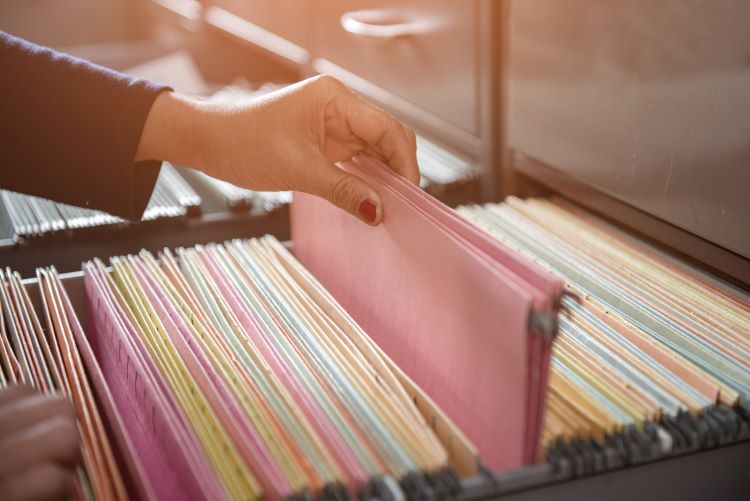
Online storage is fine, but sometimes you simply need a place to store and organize paperwork and documents for quick, hands-on access—no passwords required. Filing cabinets offer the perfect storage solution for those kinds of items.
Cabinets come in a variety of materials, shapes, and sizes. Depending on the look you want in your office, you can choose from a number of styles and finishes, too. Some cabinets lock; some are fireproof. But which type of filing cabinet is right for you?
As you shop for the perfect filing cabinet for your needs, Space Makers Junk Removal recommends that you consider these six features: size, sturdiness, ease of access, appearance, extra features, and cost.
SIZE
The size of filing cabinet that you’ll need depends on what kind of storage you need, how much you have to file, and how much space you have in your office.
WHAT ARE YOUR STORAGE NEEDS?
LETTER-SIZED VS. LEGAL-SIZED FOLDERS
Do you have a lot of letter-size folders you want to keep organized? A narrow, vertical file cabinet with deep drawers might work best for that. Or are most of your documents in legal-sized folders? Do you need a cabinet that can accommodate both kinds? Most horizontal (or lateral) cabinets have wide, shallow drawers in which you can set up both letter- and legal-sized folders.
HANGING VS. REGULAR FOLDERS
Hanging file folders have hooks that slide easily over a rods in a cabinet. A cabinet that holds hanging files will keep those files upright and easy to flip through. Regular folders, while also easy to flip through, don’t have hooks, and they sit upright in a drawer. However, if you don’t have enough folders, they can fall over in a deep drawer.
OVER- OR IRREGULAR-SIZED DOCUMENTS
If you have a lot of oversized documents like maps, house blueprints, posters, or artwork, then a flat-file cabinet with wide drawers will keep those items spread out flat so they won’t tear or crease. Smaller items like postcards or index cards can go in a special cabinet designed for those kinds of items.
HOW MUCH DO YOU NEED TO STORE?
Next, consider how many folders you have to store. If you have a lot of folders, then cramming all of them into a two-drawer cabinet will make each folder harder to access and possibly damage the cabinet. Consider a four-drawer vertical file cabinet that can accommodate a lot of folders but allow you to distribute them over several drawers. Or take a look at extra-large or extra-deep cabinets.
Another option is to consider two or more cabinets. Do you have the space for more than one cabinet, or for cabinets that you can stack?
STURDINESS
Filing cabinets come in a variety of materials and finishes, but the majority are metal or wood. As you consider what you need to file and how much you have to file, weigh the differences among the various materials.
METAL CABINETS
Metal (usually steel) cabinets are the standard for most offices because they’re sturdy, durable, and easy to move around. They’re usually waterproof, too. While most people think of gray when they think of metal file cabinets, it’s possible to get cabinets in white, silver, black, and other colors. You can also paint metal cabinets in custom colors or designs, or apply stick-on wallpaper to jazz them up for your décor.
While metal filing cabinets look sleek and modern, they are also susceptible to dents. In addition, cheaper metal cabinets can’t handle overcrowding and the drawers will warp or break under too much weight. If you have a lot of files, invest in a heavier, better quality metal cabinet.
WOOD CABINETS
Wood filing cabinets are classic and durable, and they’re a stylish option because you can choose from different types of wood, depending on your décor. If you buy a wood cabinet from an unfinished furniture store, you can even stain or paint the cabinet in a custom color to match your other furniture. And unlike metal cabinets, they’re less prone to dents or warping with time, and the drawers are quieter than metal.
Although wood cabinets are attractive, they’re also heavy and therefore hard to shift around. They’re also subject to scratches, dinks, and cracks. And just like with metal cabinets, cheaper versions can break more easily if overloaded.
EASE OF ACCESS
Think about how you’re going to use a filing cabinet. Is it going to be used to store files you need to look at only once in a while, or will you need to get to files daily? Or even hourly? If you need files at your fingertips as you work, consider a filing cabinet that fits under your desk or one that has wheels.
Make sure the cabinet you choose works with your organization system. For example, does it have a place to insert labels on the outside? If you like to place folders within folders, is the cabinet sturdy enough to accommodate that much weight, and do the drawers pull out far enough for you to quickly access folders at the back?
If you have issues with your hands, are the handles easy to pull? Are they sturdy handles, unlikely to come loose?
APPEARANCE
If the standard, blocky filing cabinet isn’t for you, you can find cabinets in other shapes, styles, and materials. From sleek, space-age curves to warm, nature-inspired wicker, there are filing cabinets to match all kinds of office décor. Check out these top picks from thespruce.com.
EXTRA FEATURES
In addition to storage capacity, durability, and appearance, what else do you need in a filing cabinet?
LOCKING CABINETS
A locking file cabinet can provide extra security for your documents. Some cabinets come with locks you open by key, while others have keypads for codes or push button locks. Not all cabinets will lock all drawers. Some four-drawer cabinets, for example, will lock only the top two drawers.
However, if you have documents that you need to keep especially secure, a locked filing cabinet isn’t the best place to store them. According to United Locksmith, the locks manufacturers install in file cabinets are relatively easy to pick or break, and the keys that come with those locks are easy to duplicate. United Locksmith recommends getting a locksmith to switch out manufacturer’s locks with more secure ones. In addition, you can ask a locksmith to install a locking bar on the outside of a cabinet for extra security.
FIREPROOF CABINETS
If you have legal documents or one-of-a-kind family documents you need to keep safe, then a regular filing cabinet isn’t your best bet. Basic metal filing cabinets can’t withstand the high temperatures of a fire, and the documents inside will burn. Fireproof cabinets are heavier and more expensive, but they’re built to withstand fires and keep documents inside from being destroyed. Make sure you find a cabinet with a UL (Underwriter’s Laboratory) rating for the types of documents you want to keep in your cabinet. For example, some cabinets are rated just for paper, while others protect photos or computer disks. In addition, look for cabinets UL rated to withstand building collapse, falling from upper stories, and water damage.
OTHER FEATURES
ANTI-TILT MECHANISMS
A file cabinet can tip over if you open more than one drawer at a time, spreading paperwork everywhere. In addition, a large filing cabinet can hurt someone if it falls over. Anti-tilt mechanisms keep that from happening by making it possible to open only one drawer at a time.
WHEELS OR CASTORS
If you anticipate moving your office furniture around frequently, or you need a filing cabinet to fit under your desk, a filing cabinet with wheels or castors is more moveable than a regular cabinet.
LABEL INSERTS
Not all filing cabinets come with places to insert a label, so if having a drawer labeled is important to you, choose a cabinet that has a place to insert or stick on a label.
COST
Costs for a filing cabinet will vary based on the number of drawers, the type of material and its sturdiness, the size of the cabinet, and whether or not it has a lock. You get what you pay for: cabinets with sturdier construction—whether wood or metal—will cost more than flimsier cabinets, but they’ll likely last longer. Two-drawer vertical cabinets can cost as little as $20 or as much as $150, while two-drawer lateral cabinets cost more, up to $600. Cabinets with four or five drawers can cost as little as $250; higher-end models can run over $1000. Fire- and waterproof models will be the most expensive, between $1000 to $1500 for a two-drawer model, and $1500 to $4000 for models with more drawers.
CALL SPACE MAKERS TO GET RID OF OLD CABINETS


